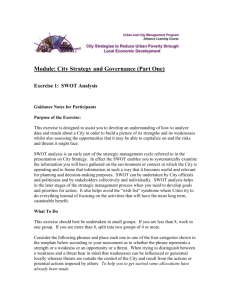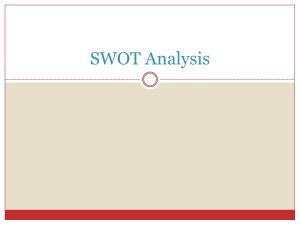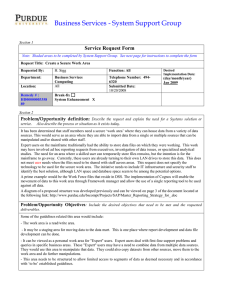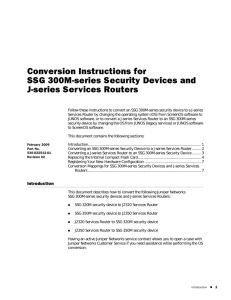Stock Study Template
advertisement
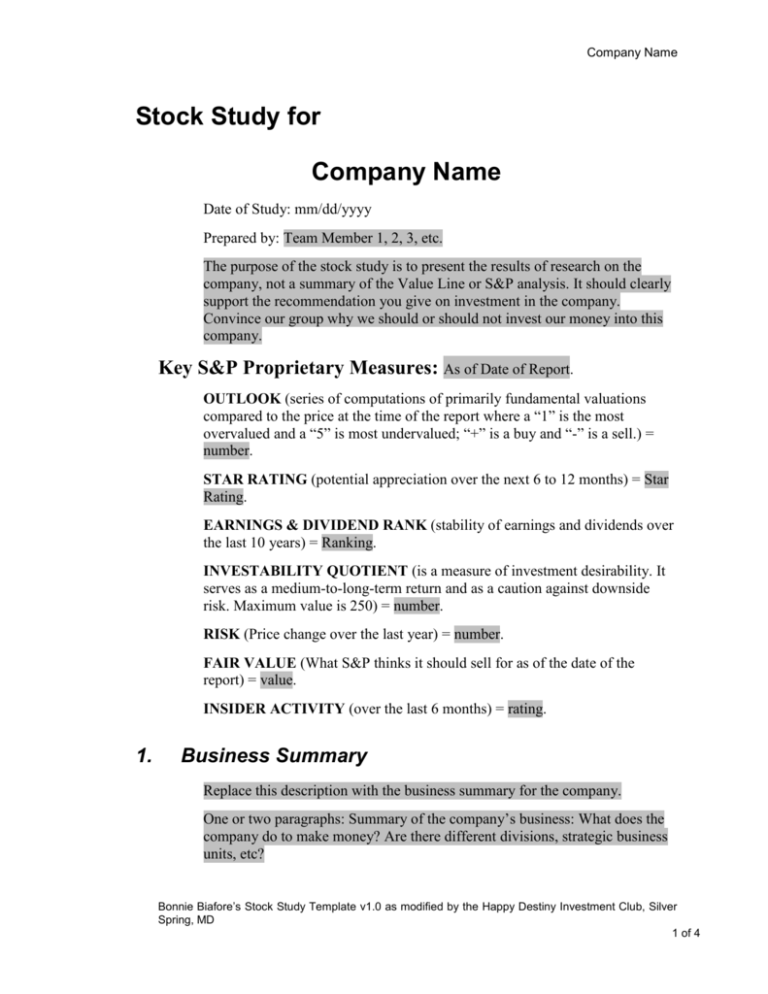
Company Name Stock Study for Company Name Date of Study: mm/dd/yyyy Prepared by: Team Member 1, 2, 3, etc. The purpose of the stock study is to present the results of research on the company, not a summary of the Value Line or S&P analysis. It should clearly support the recommendation you give on investment in the company. Convince our group why we should or should not invest our money into this company. Key S&P Proprietary Measures: As of Date of Report. OUTLOOK (series of computations of primarily fundamental valuations compared to the price at the time of the report where a “1” is the most overvalued and a “5” is most undervalued; “+” is a buy and “-” is a sell.) = number. STAR RATING (potential appreciation over the next 6 to 12 months) = Star Rating. EARNINGS & DIVIDEND RANK (stability of earnings and dividends over the last 10 years) = Ranking. INVESTABILITY QUOTIENT (is a measure of investment desirability. It serves as a medium-to-long-term return and as a caution against downside risk. Maximum value is 250) = number. RISK (Price change over the last year) = number. FAIR VALUE (What S&P thinks it should sell for as of the date of the report) = value. INSIDER ACTIVITY (over the last 6 months) = rating. 1. Business Summary Replace this description with the business summary for the company. One or two paragraphs: Summary of the company’s business: What does the company do to make money? Are there different divisions, strategic business units, etc? Bonnie Biafore’s Stock Study Template v1.0 as modified by the Happy Destiny Investment Club, Silver Spring, MD 1 of 4 Company Name 2. Business Outlook Replace this description with the business summary for the company. One to six paragraphs: Summary of positive and negative impacts on the company, such as successful strategies, acquisitions or divestitures, cost cutting, or cost increases, the economy, money exchange rates, war, competition. Summarize business strategy – does business grow from acquisitions, increased market share, more volume, more stores, better margins, new products. For example, Oracle using their productivity products on their own business to cut costs, or Home Depot eliminating the middle man to increase their profit margins. 3. SWOT Analysis Replace this description of SWOT with the summary of the SWOT analysis for the company SWOT stands for strengths, weaknesses, opportunities, and threats. SWOT analysis provides a framework for analyzing a company’s existing situation: its own strengths and weaknesses as well as the opportunities and threats posed by the external environment within which it operates. Start with an inward look at the company’s existing strengths and weaknesses, such as its existing product range; fixed asset base; human resources and managerial capacity. Then follow with an ‘outward look’ at the opportunities and the threats in its operating environment. You might examine issues such as changes in consumer demand for the company’s products and services; the competitors that the company faces in the market-place and the affect of technological change on the company, its products and its organization. The tables are not an exhaustive list, but rather examples to stimulate ideas. Items might appear under more than one heading e.g. a weakness can turn into an opportunity. Include any comments or items of interest you discover in the course of filling out the SWOT tables. Strengths: High or dominant market share Strong brand recognition and strength of product Cash flow – “Stars and Cash Cows” Good quality management Low debt ratios Strong fixed and liquid assets Broad client base Operating in diverse markets and product ranges Weaknesses: Low market share Products facing obsolescence – patents expiring Cash flow – “Dogs” Poor management High debt ratios Low ROA and/or Quick Ratio Narrow client base Narrow product line / geographic location Bonnie Biafore’s Stock Study Template v1.0 as modified by the Happy Destiny Investment Club, Silver Spring, MD 2 of 4 Company Name Good credit ratings, can borrow money High barriers to market entry Strong/continual R&D for product development and product life extension Uses information technology such as Just In Time mfg Other: Bad credit ratings, can’t borrow money Low or few barriers to market entry Little or no R&D Qualitative Total Qualitative Total Opportunities Not using information technology to increase productivity Other: Threats: New markets Extending product life cycles Cash Flow “Question Marks” Expansion – regional / national / international Market consolidation Takeovers / economy of scale Borrowing capabilities Product repositioning / reengineering i.e. life cycle expansion New technology enhances products and productivity Other: Qualitative Total 4. Loss of major clients Patents not renewed Adverse changes in interest rates on debt New entrants to the market Market consolidation Takeover Alternate/competing products Repositioning of products from “Stars, Cash Cows, or ? to Dogs” New technology renders products or services obsolete Other: Qualitative Total Quantitative Analysis This section focuses on the quantitative analysis of the company using the SSG and ratio comparisons. Make sure to research and explain any unusual numbers or patterns, or values significantly below or above the industry average. 4.A SSG Section 1 Growth Rates Opinion on quality of historical growth Estimated future growth – and why Explain any unusual occurrences and outliers in Section 1 graph (dips, spikes, deficits, change in growth rates) Bonnie Biafore’s Stock Study Template v1.0 as modified by the Happy Destiny Investment Club, Silver Spring, MD 3 of 4 Company Name 4.B 4.C 4.D 4.E 5. SSG Section 2 Management Opinion on section 2 numbers and trends Explain any unusual occurrences and outliers, compare to industry numbers SSG Section 3 PEs Opinion on historical PEs and outlook for future Explain any outliers and decisions on averages SSG Section 4 Explain choice of high and low PE Explain choice of low EPS and low price Relative value Ratio Analysis Explain ratios chosen Comparison of ratios to industry Investment Recommendation Summarize reasons for recommendation Not a good company If buy, at what price Hold If OK in portfolio, but something to watch, i.e. dropping profit margins or market share Bonnie Biafore’s Stock Study Template v1.0 as modified by the Happy Destiny Investment Club, Silver Spring, MD 4 of 4


